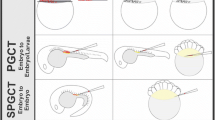Abstract
Biotechnology can currently be considered of importance in aquaculture. The increase in the production of aquatic organisms over the last two decades through the use of biotechnology indicates that in a few generations biotechnology may overtake conventional techniques, at least for the commercially more valuable species. In the last few years, genetics has contributed greatly to fish culture through the application of the more recent techniques developed in biotechnology and in genetic engineering. At present, the most commonly used methods in fish biotechnology are chromosome manipulation and hormonal treatments, which can be used to produce triploid, tetraploid, haploid, gynogenetic and androgenetic fish. These result in the production of individuals and lineages of sterile, monosex or highly endogamic fish. The use of such strategies in fish culture has as a practical objective the control of precocious sexual maturation in certain species; other uses are the production of larger specimens by control of the reproductive process and the attainment of monosex lines containing only those individuals of greater commercial value. The use of new technologies, such as those involved in gene transfer in many species, can result in modified individuals of great interest to aquaculturists and play important roles in specific programmes of fish production in the near future.
Similar content being viewed by others
References
Bakos, J., 1979. Crossbreeding Hungarian races of common carp to develop more productive hybrids. In Pillay, T. V. R. & W. Dill (eds), Advances in Aquaculture. Fishing News Books, Farnham, Surrey, UK: 633–635.
Bakos, J. & S. Gorda, 1995. Genetic improvement of common carp strains using intraspecific hybridization. Aquaculture 129: 183–186.
Berkowitz, D. B. & I. Kryspin-Sorensen, 1994. Transgenic fish: safe to eat? A look at the safety considerations regarding food transgenics. Biotechnology 12: 247–252.
Donaldson, E. M., 1997. The role of biotechnology in sustainable aquaculture. In Bardach, J. E. (ed.), Sustainable Aquaculture. John Wiley & Sons, New York.
Dunhan, R. A., 1999. Utilization of transgenic fish in developing countries: potential benefits and risks. J.Word aquacult. Soc. 30: 1–11.
Hallerman, E. M. & A. R. Kapuscinki, 1995. Incorporating risk assessment and risk management into public policies on genetically modified finfish and shellfish. Aquaculture 137: 9–17.
Iyengar, A., F. Muller & N. Maclean, 1996. Regulation and expression of trangenes in fish-a review. Transgen. Res. 5: 147–166.
Kapuscinski, A. R. & E. M. Hallerman, 1991. Implications of introduction of transgenic fish into natural ecosystems. Can. J. Fish. aquat. Sci. 48: 99–107.
Lutz, C. G., 1997a. Tinkering with chromosomal complements: gynogenesis-an introduction. Aquacult. Magaz. 23: 67–71.
Lutz, C. G., 1997b. Gynogenesis part II: examining recent work. Aquacult. Magaz. 23: 73–78.
Lutz, C. G., 1998a. Triploidy: potential and problems. Aquacult. Magaz. 24: 92–95.
Lutz, C. G., 1998b. Gynogenesis part III. Aquacult. Magaz. 24: 75–78.
Nagy, A., K. Rajki, J. Bakos & V. Csányi, 1979. Genetic analysis in carp (Cyprinus carpio) using gynogesesis. Heredity 43: 35–40.
Parsons, J., 1998. Status of genetic improvement in commercially reared stocks of rainbow trout. World Aquacult. 29: 44–47.
Purdom, C. E., 1993. Genetics in fish breeding. Chapman & Hall, London, 277 pp.
Toledo-Filho, S. A., F. Foresti & L. F. Almeida-Toledo, 1996. Biotecnologia genética aplicada à piscicultura. Cadernos de Genética 3, CCS/USP, São Paulo, Brazil.
Author information
Authors and Affiliations
Rights and permissions
About this article
Cite this article
Foresti, F. Biotechnology and fish culture. Hydrobiologia 420, 45–47 (2000). https://doi.org/10.1023/A:1003973317992
Issue Date:
DOI: https://doi.org/10.1023/A:1003973317992



